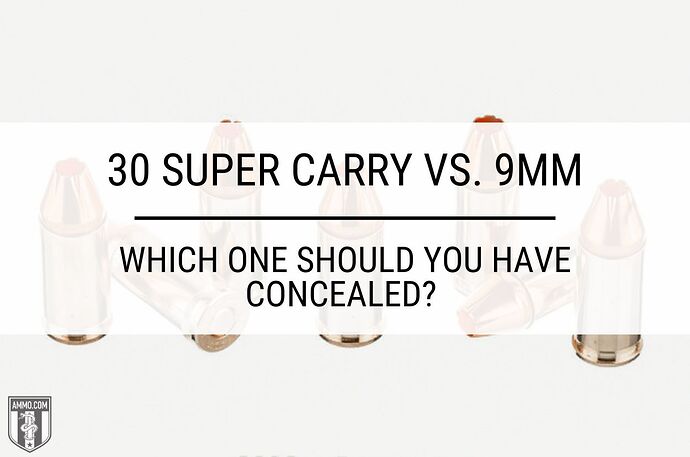It’s only natural to compare the 30 Super Carry vs. 9mm. After all, the .30 Super Carry was designed to offer gun owners a higher magazine capacity than the 9mm and better ballistic performance than the 380 ACP.
Is that actually possible? Can a new cartridge outperform the time-tested 9mm Luger? Or should you stick with the tried and true concealed carry option?
Let’s find out!
30 Super Carry vs. 9mm
The Federal 30 SC is a new cartridge that aims to fill the capacity and performance gap between the 9mm and 380 Auto.
Many self-defense enthusiasts have preferred the 9mm over the decades. Has its reign finally ended?
As we continue, you’ll discover the differences and similarities in cartridge specs, recoil, trajectory, accuracy, stopping power, and other important categories. We’ll finish it all off by crowning a winner.
Technical Specs: 9mm vs. 30 Super Carry
As they’re designed to fulfill a similar purpose, it’s no surprise that the 9mm and 30 Super Carry have similar characteristics.
The much older 9x19mm was based on the 7.62x21mm. Federal Premium claims that the 30 Super Carry is an original handgun cartridge design. It resembles the 7.65mm French Long, .30-18 Auto, and 7.65x20mm Long.
The 30 Super Carry’s bullet diameter is 0.312 inches, compared to 0.355 inches for the larger 9 mm. The case lengths vary slightly, with the Federal 30 SC being marginally longer at 0.827 inches and the 9mm at 0.754 inches. The Federal .30 Super Carry also has a higher maximum pressure: 50,000 psi, as opposed to the 9mm at 35,000 psi.
Both cartridges have an identical overall length of 1.169 inches. The smaller base diameter of the 30 SC helps shooters differentiate the two cartridges.
Recoil
Recoil is an important consideration when purchasing a new cartridge or handgun, as a heavy recoil round is more difficult to control and slows the rate of your follow-up shots. You’re also at an increased risk of flinching when firing heavy-recoil loads.
Felt recoil is subjective, differing from shooter to shooter and depending on the firearm, stance, handloads, or factory ammo. However, free recoil is a more objective measure of the amount of kick a cartridge delivers. It is based on four factors: firearm weight, muzzle velocity, propellant weight, and bullet weight.
Neither cartridge is known for heavy recoil, as this (along with increased capacity) is why many shooters opt for 9mm over 45 ACP for self-defense. Since both cartridges are chambered in the same pistols (Smith & Wesson Shield EZ has a 9mm version and a 30 Super Carry version), we can objectively compare the recoil of each.
The 30 Super Carry is consistently considered to have less felt recoil than the 9mm. This is thanks partly to the 30 SC’s lighter bullet: 100 grains, as opposed to the 9mm’s usual 115-147 grains. The 9mm only has 4 ft-lbs of free recoil; however, the 30 Super Carry has 3.8 ft-lbs of free recoil.
Though the 30 Super Carry has slightly less recoil than the 9mm, it’s not significant enough for you to notice a difference while firing the rounds. This section is a draw.
Accuracy
Many factors determine a round’s accuracy, including (but not limited to) the shooter, bullet design, trajectory, firearm, recoil, and shooting conditions.
Since these rounds are so similar in many respects, it ultimately comes down to the shooter. The 30 Super Carry cartridge has less recoil by a hair, but I don’t believe this difference is significant enough to affect your accuracy.
Most shooters will find the 30 SC and 9mm to be accurate. I’m very accurate with my 9mm pistols within 25 yards, which is the range most self- and home-defense situations play out over.
This section is a draw, as both rounds are similarly accurate.
Continue reading 30 Super Carry vs. 9mm: Which One Should You Have Concealed? on Ammo.com


